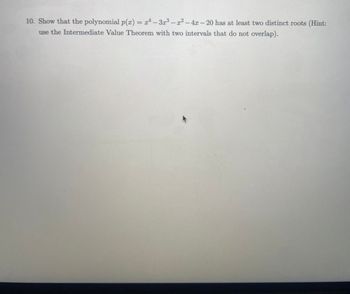
Calculus: Early Transcendentals
8th Edition
ISBN: 9781285741550
Author: James Stewart
Publisher: Cengage Learning
expand_more
expand_more
format_list_bulleted
Question

Transcribed Image Text:10. Show that the polynomial p(x) = x²-3x³ - x² - 4x-20 has at least two distinct roots (Hint:
use the Intermediate Value Theorem with two intervals that do not overlap).
Expert Solution
This question has been solved!
Explore an expertly crafted, step-by-step solution for a thorough understanding of key concepts.
This is a popular solution
Trending nowThis is a popular solution!
Step by stepSolved in 3 steps with 1 images

Knowledge Booster
Similar questions
- For the polynomial f(x) = 13(x – 6)(66 – 37x²) (a) Report the exact values of the zeros. 0 第。 66 66 -6 37' V 37' 66 66 37' V 37' 37 37 O 13, - 66' V 66' -6 66 66 O 13, – -6 37' V 37' 37 37 66' V 66 , 6 66 66 O 13, 37' V 37' 37 37 О 13, 66' V 66 37 37 -6 66' V 66' O None of these. (b) Report the coordinates of the y-intercept. ( Number Numberarrow_forward9. Sketch a higher degree polynomial with the following roots: -2, 3, -3, 6. f(x)arrow_forward2(×+2)^2-18=0 is the equation resulting from setting a quadratic fuction f(×) equal 0 and completing the square .which of the following statements about f(×) is true. A.f(×)has an axis of symmetry at x=-2. B.f(×) has its vertex at (2, -18) C. F(×) has an axis of symmetry at x= -18. D.f(×) has a graph that opens downward.arrow_forward
- Find the zero(s) of the polynomial ³ - x²-3x+3. Enter your answer as one or more numbers, separated vo: € ∞o an di II lim (0) [0] > ≤E CUN 5 010 ✓0 %90 0 4 10 (0) t 1 1arrow_forwardFind all zeros of f(x) = 4x – 20x² + 31lx – 21. Enter the zeros separated by commas. Enter exact value, not decimal approximations.arrow_forwardCreate a polynomial function of the form: f(x) = a (bx + e)(cx +g}*(dx + h)°, with the following conditions: i) a,b,c,d,e,g.h are non-zero integers. ii) the three factors must be different ii) a,b,c,d can all be set to one if you like iv) f(x) has to pass through all 4 quadrants Use your Curve Sketching Plan to fully characterize your function and draw an accurate sketch showing all significant features.arrow_forward
- For the polynomial below, 1 is a zero. h (x)=x' 7x + 10x 4 | Express h (x) as a product of linear factors. h (x) = 0arrow_forward3.2 (2) Divides the polynomialarrow_forward9. Find all real zeroes of the function p(x)= 6x' +17x – 26x +8 Solution: https://youtu.be/XBNPBY4SAB8 10. Construct a polynomial with real coefficients that has zeroes 2 and 3+i. Solution: https://youtu.be/J9c9czrqFJA 11. Find all real/complex zeroes and write the polynomial in factored form. p(x) = 3x* – 29x +101x² – 119x – 52 Solution: https://youtu.be/78Tdn3Y0dj4 x- 4 12. Express the domain in interval notation: R(x)=- x+7 %3Darrow_forward
arrow_back_ios
arrow_forward_ios
Recommended textbooks for you
 Calculus: Early TranscendentalsCalculusISBN:9781285741550Author:James StewartPublisher:Cengage Learning
Calculus: Early TranscendentalsCalculusISBN:9781285741550Author:James StewartPublisher:Cengage Learning Thomas' Calculus (14th Edition)CalculusISBN:9780134438986Author:Joel R. Hass, Christopher E. Heil, Maurice D. WeirPublisher:PEARSON
Thomas' Calculus (14th Edition)CalculusISBN:9780134438986Author:Joel R. Hass, Christopher E. Heil, Maurice D. WeirPublisher:PEARSON Calculus: Early Transcendentals (3rd Edition)CalculusISBN:9780134763644Author:William L. Briggs, Lyle Cochran, Bernard Gillett, Eric SchulzPublisher:PEARSON
Calculus: Early Transcendentals (3rd Edition)CalculusISBN:9780134763644Author:William L. Briggs, Lyle Cochran, Bernard Gillett, Eric SchulzPublisher:PEARSON Calculus: Early TranscendentalsCalculusISBN:9781319050740Author:Jon Rogawski, Colin Adams, Robert FranzosaPublisher:W. H. Freeman
Calculus: Early TranscendentalsCalculusISBN:9781319050740Author:Jon Rogawski, Colin Adams, Robert FranzosaPublisher:W. H. Freeman
 Calculus: Early Transcendental FunctionsCalculusISBN:9781337552516Author:Ron Larson, Bruce H. EdwardsPublisher:Cengage Learning
Calculus: Early Transcendental FunctionsCalculusISBN:9781337552516Author:Ron Larson, Bruce H. EdwardsPublisher:Cengage Learning

Calculus: Early Transcendentals
Calculus
ISBN:9781285741550
Author:James Stewart
Publisher:Cengage Learning

Thomas' Calculus (14th Edition)
Calculus
ISBN:9780134438986
Author:Joel R. Hass, Christopher E. Heil, Maurice D. Weir
Publisher:PEARSON

Calculus: Early Transcendentals (3rd Edition)
Calculus
ISBN:9780134763644
Author:William L. Briggs, Lyle Cochran, Bernard Gillett, Eric Schulz
Publisher:PEARSON

Calculus: Early Transcendentals
Calculus
ISBN:9781319050740
Author:Jon Rogawski, Colin Adams, Robert Franzosa
Publisher:W. H. Freeman


Calculus: Early Transcendental Functions
Calculus
ISBN:9781337552516
Author:Ron Larson, Bruce H. Edwards
Publisher:Cengage Learning